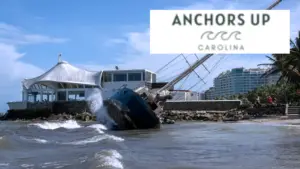Without question, the southeastern shoreline of the United States is prone to tropical storm systems on an annual basis. Of course, the severity varies from tropical depressions to category five hurricanes. When tropical weather approaches, it is critical to prepare your waterfront home. When I refer to a waterfront home this can be anything from beachside to a small tidal creek inland of the ocean. You need to know how to do tropical storm preparation if you live in the southeast on the water.
Why Waterfront Homes Sustain Damage From Storms
Unquestionably, waterfront homes are at higher risk of damage from storms for a multitude of reasons. One of the reasons is wind damage. The wind is able to travel unobstructed for long distances. For this reason, the force the is stronger when compared to inland areas as it travels through trees, buildings, and other structures.
The second and often forgotten impact is flooding. Combining heavy rains and storm surge raises water levels significantly. As a result, water inundation is highly likely causing significant damage to homes. Additionally, rapidly rising water traps unsuspecting people who require rescue.
Risks Associated With Tropical Weather And Waterfront Property
Waterfront property owners need to take extra precautions when it comes to preparing for tropical storm systems. Again, due to location, the property, belongings, docks, and boats are all at high risk in hurricanes and tropical storms. Here are the risks associated with tropical weather.
Wind
There is no question about it: Tropical systems are packed with powerful, sustained winds. Of course, this varies based on the intensity. For example, category five will level some structures where a tropical storm may cause the loss of a shingle or two from the roof.
When it comes to preparation, consider everything moveable in your yard to be a flying object. Yes, furniture will become airborne if not properly secured.
To best prepare, move all furniture into the garage, including pieces on docks, secure potted plants, remove and stow sun umbrellas, place cushions indoors, and tie up garbage cans. Importantly, walk your entire property, including the dock, and look for any other loose items. Remember, objects that become airborne put your house at risk. Unfortunately, year after year, household items end up sailing through windows.
Lastly, if you own a boat and it is dockside, you’ll need to take extra measures to ensure it’s secured. With the boat alongside a dock, remove the cover, add extra fenders along the hull, and double up on dock lines. It should be noted if you have a boat lift, I suggest lowering the boat into the water and securing it to the dock. Leave the cradles beneath the waterline to reduce the likelihood of damage.
Tidal Flooding
Tidal flooding is extremely common in tropical systems. Again, the level of flooding is highly dependent on the intensity of the storm.
Importantly, tidal flooding is highly impacted by the tide cycle. Flooding is more severe during high tide in comparison to low tide. This is especially the case if the storm’s peak winds occur simultaneously with high tide.
It goes without saying that unsecured objects are at risk of floating away. Additionally, docks become severely damaged by rising water, as often the deck boards will pop free.
Look, objects can be replaced, but people cannot. The biggest risk of tidal flooding is people drowning. If you are expecting a high storm surge, simply get out ahead of time. Staying put causes people to become trapped as water levels rise inside of the house.
Lightening
I’ll be honest: most hurricanes do not have lightning present however, this is not the case in every situation.
No matter if the chances are low, you do not want to put yourself at risk of a lightning strike. Importantly, secure all items before the storm approaches. Preparing ahead of time will prevent you from being outdoors when lightning is present. Lastly, understand that electronic devices are at risk of being blown out by power surges.
Tropical Storm Preparation: Prepare Ahead Of Time
In the southeast, you’ll need to be on guard between July and November; however, the peak of tropical activity is between August and October. Without a doubt, preparing ahead of time is critical. Don’t wait until the final moments. Most importantly, if you’re ordered to evacuate, don’t stay home. It’s just not worth it. Too many people have elected to stay home only to be killed or require a rescue. Remember, you’re putting other people at risk if you choose to stay home when ordered to evacuate. The rescue crews are forced to brave the elements as a result of a poor decision.






